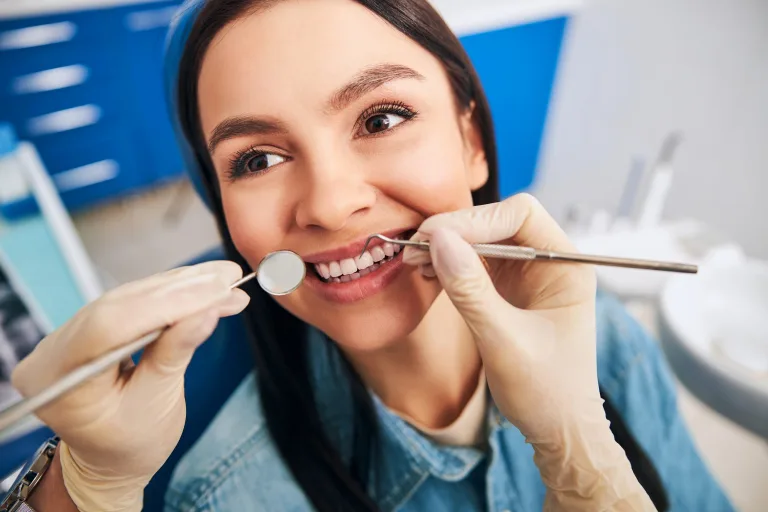What you do between dental visits to maintain healthy teeth and gums is as important as visiting your dentist regularly. Many people don’t realize that there are real benefits to a regular between-visit oral hygiene routine. This routine goes beyond just brushing twice a day. Below we will discuss how you can get the most out of your at-home dental regiment.
Brushing
Okay, we know you all understand that brushing your teeth is essential, but did you know that the way you brush, the product you use to brush, and your age can all be factors in whether or not this routine will work for you? It’s true! There is a lot that goes into brushing that can make or break a good oral hygiene routine.
The Right Toothbrush
First of all, it’s important to understand that not all toothbrushes are created equal. Modern technologies have improved the toothbrush, but that doesn’t mean that there is one brush that is perfect for every individual.
The American Dental Association recommends brushing your teeth twice a day every day with a soft-bristled toothbrush. Beyond those recommendations, you have to choose between many types of toothbrushes and understand which type is best for you.
Manual vs. Power
Commercials for power toothbrushes are everywhere. They constantly claim that they remove more plaque than manual brushes. This is not always the case, and in some instances, these brushes are not a good choice.
Teens with braces, for instance, or people who have crowns and cavities need to be careful with these brushes, as the speed and intensity of some power brushes could damage or remove them.
Power brushes have some major bonuses, however. They are easier to use, so many kids learning to brush on their own or older adults with disabilities or movement issues can benefit from the automatic movements of power brushes vs. manual.
There are many forms of power brushes and many ways in which these brushes move to clean the most plaque at a time. Some power brushes even keep track of how long you have been brushing, so you are guaranteed to get your full two minutes in twice each day.
Manual toothbrushes come in many shapes and sizes as well. Studies show that manual toothbrushes that feature bristles that are uneven or angled are better for removing plaque than those with simple flatheads. Ensuring that you are brushing in a circular pattern with these brushes is vital to remove the maximum amount of plaque and avoid tooth decay and cavities in the future.
Brushing Through the Ages
An excellent tooth brushing routine should begin as soon as a child’s first tooth appears. This is also when you should schedule your child’s first dental checkup. Starting out early with oral health and wellness is an important part of ensuring great hygiene and health for years to come!
There are brushes made especially for babies and young children to start getting them used to the idea of brushing regularly. There are even specially made types of toothpaste with more child-friendly flavors. The American Dental Association also provides fun comics to help kids get excited about brushing and flossing. Talk to your dentist to get more ideas on how to maintain your child’s oral health.
Once children start to brush and floss regularly, they should not ever stop. Good oral hygiene must be maintained throughout your life, even if you find yourself at some point without any more real teeth. Caring for your dentures and gums is as important is caring for your teeth. You are still at risk for gum disease as well, so maintaining healthy gums is crucial for denture wearers.
Flossing
Every dentist will tell you the importance of flossing in addition to your tooth brushing routine. Flossing helps to get hard to reach food particles and plaque out from between the teeth. Flossing is critical because toothbrushes cannot get to all of the places where floss and other interdental cleaners can reach. Flossing or using other interdental cleaners once a day has significant benefits to your oral health.
Technique is Important
How you floss is as important as how you brush so that you are cleaning the most surface area without damaging the gums or accidentally removing crowns or fillings. Proper technique will also help you to keep the bad stuff out one you have begun the flossing process. Following the steps below will help you to get the most out of your floss:
- Rip out about 18 inches of floss from your container.
- Wrap most of the floss around the middle finger on one hand and just a small portion of the other end around the middle finger on your opposite hand.
- Hold the loose floss tightly between your thumb and forefinger.
- Use a gentle rubbing motion to guide floss between the teeth (do not snap floss against gums—this could cause damage).
- Once the floss has reached your gums, make a c-shape with it so that it sits against one side of one tooth.
- Move the floss back and forth against the side of the tooth, gently.
- Repeat this motion against the side of the opposing tooth.
- Once you have cleaned both teeth in the space where you began, move to the next gap.
- Continue to wrap the dirtied floss around the finger that held very little floss to begin with and open up clean space by unwinding floss on the finger that initially contained the majority of the floss.
- Keep up this routine until you have hit both sides of every tooth, and don’t forget the back side of the back teeth!
Avoid Tobacco
Smoking and chewing tobacco put you at much more significant risk for gum diseases and tooth decay than individuals who avoid these activities all together. Not only does the tobacco harm your teeth and gums, but many people will also try to cover up the smell with candies, mints or coffee, all of which also affect your oral health negatively. Also remember that second-hand smoke is just as dangerous.
Step Away from the Sugary and Acidic Drinks
Tobacco is not the only habit that hurts your teeth. Sugary and acid-filled drinks can damage the enamel on teeth and put you at a higher risk for gum disease and cavities. Avoiding these types of drinks, including sodas, coffee, alcohol, and even some fruit juices is beneficial for your overall oral health.
You may think that you can get around this one by drinking sugar-free or diet sodas, but that is not true. All sodas contain acids that will combine with the bacteria in your mouth to attack the enamel on your teeth. Any damaged enamel can allow cavities to form, so staying away from all sodas, or at least limiting your intake, is advised.
Calcium, Vitamin D, and Phosphorous
Getting the minimum daily recommended amount of calcium is important to keep teeth and the bones and ligaments that support them healthy. Eating calcium-rich foods such as brown rice, oranges, cabbage, and beans can help to promote healthy teeth and gums.
Proper vitamin D intake is also important to maintain oral health. Vitamin D regulates and helps to promote the absorption of calcium and phosphorous in the body, so it is a very important part of your routine. Getting just 15 minutes of direct sunlight daily can get you the recommended amount of vitamin D. If that is not an option where you live, you could also eat more dairy and greens.
Finally, calcium needs phosphorous to maximize its benefits, so ideally you need to ensure that you are getting the recommended daily values of both. Phosphorous is found in wheat germ, poultry, fish, almonds and other nuts, and cucumbers among other things.
Wrapping Up
Maintaining a healthy routine between dental visits is vital to your overall health. To do so, you need to ensure that you take care of your teeth daily, while also focusing on your diet. Diets rich in sugary and acidic foods are sure to cause more harm to your teeth, so try your best to avoid them.
Staying away from tobacco, and ensuring that you are getting enough calcium, vitamin D, and phosphorous is also very important to maintain great oral health. Your dental team is happy to talk to you individually about how you can maintain a healthier lifestyle if you need advice or a place to begin.
Finally, make sure that you are committed to brushing twice a day with the right toothbrush for you. Also, flossing once a day will not only reduce your risk of cavities, it will maintain healthier gums, but make sure you are not causing damage to your gums by using the incorrect technique. Doing all of this will help to keep your smile healthy and keep bacteria at bay for years to come.



